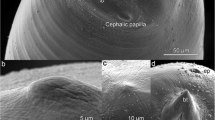Summary
Description ofNyctotherus parasite ofPeriplaneta americana found in Gôa. Detailed description of some organels, as the caryophore diaphragm with its frontal lamina as well as of the neuromotor apparatus attached as an appendix to the cytopharynx and the fibrillæ in the lumen of the cytopharynx. Confirmation of the existence of sub-pharyngeal canal as described by Higgins inN. cordiformis. Divisional stages with mitosis of micronucleus preceded by premitotic phenomena consisting of a reduction of the caryosome to nuclear dust, formation of centriole and rudimentary diaster. Four chromosomes stated. Amitosis of macronucleus. Three morphological types: (a) micronucleus separate from macronucleus, anal groove simple; (b) micronucleus embedded in the mass of macronucleus, anal groove with one border mamilonated; (c) transitional type with nuclear apparatus as in (a) and anal groove as in (b). All these types are variations of one single species,N. ovalis Leidy.
Similar content being viewed by others
Bibliography
Leidy, J. No title to paper. Indexed as “On the existence of Entophyta in healthy animals as a natural condition.”Proc. Acad. Nat. Sci., 1849,4, 233.
—Do. “Two new species of Infusorial Entozoa.”Ibid.,, 1850,5, 100.
Ghosh, E. N. “Infusoria from the environment of Calcutta.”Bull. of the Charmicœl Med. College, Belgachia, No. II, 1921.
Bhatia, B. L., and Gulati, A. N. “On some parasitic ciliates from Indian frogs, toads, earthworms and cockroaches.”Archiv. für Protistenk., 1927, L.7, 85–120.
Doflein Franz.Lehrbuch der Protozoenkunde, 1927.
Wenyon, C. M.Protozoology, 1926.
Calkins, G. N.The Protozoa, 1901.
Do. Calkins, G. N.Protozoology, 1910.
Lankester, Ray E.A Treatise on Zoology, Part I. Introduction and Protozoa. Second Fascicle, 1903.
Zulueta, A. de “Sobre la estructura y biparticion deNyctotherus ovalis Leidy.”Traf. Mus. Nac. Cienc. Natur. Ser. Zool., Madrid, 1916.
Lima Ribeiro, Miss J. “Morphologie et cycle évolutif duNyctotherus ovalis Leidy.”Bull. Soc. Portug. Sci., Nat., 1924, T.10, 2–3.
Dobell, C. C. “On some Parasitic Protozoa from Ceylon. ‘Spolia zeylanica»,” 1910,7, Part XXVI, 65–87.
Grassé, P. P. “Sur quelquesNyctotherus (Infusoires heterotriches) nouveaux ou peu connus.”Ann. Protistologie, 1928,1, 55–58.
Kirby, Jr. Harold “Protozoa in termites of the genus Amitermes.”Parasitology, 1932,24, No. 3, 289–304.
Zeliff, Clarke Courson “A new protozoan from the larva of the beetleOsmoderma seabra.”Proc. of the Unit. Stat. Nat. Museum, 1933,82, No. 2964, 1–3.
Ten Kate, C. G. B. “Uber das Fibrillen system der Ciliaten.”Arch. Protistenkunde, 1927, L.7, 362–426.
Author information
Authors and Affiliations
Rights and permissions
About this article
Cite this article
Froilano de Mello, I., Carvalho, J.I. & Gaitondó, P. Cytological studies onNyctotherus ovalis with special reference to its morphological types. Proc. Indian Acad. Sci. 1, 249–257 (1934). https://doi.org/10.1007/BF03039744
Received:
Issue Date:
DOI: https://doi.org/10.1007/BF03039744




